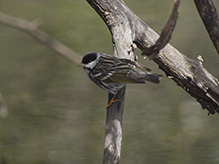Blackpoll Warbler
(Setophaga striata)
Conservation • Description • Habitat • Ecology • Distribution • Taxonomy
Conservation Status |
|||
| IUCN Red List | NT - Near Threatened |
||
| NatureServe | N5B - Secure Breeding SNA - Not applicable |
||
| Minnesota | not listed |
||
Description
The black cap and plump shape of the breeding male are similar to the Black-capped Chickadee, but the similarity ends there. The throat and cheek are white and divided by a black “chin” stripe. The back is olive-gray with black streaks. The underparts are white and have black streaking. The wings have two white wing bars. The legs are orangish-yellow. Non-breeding males and females have an olive-yellow head and upper parts and a yellow “eyebrow”.
Size
Total length: 5″ to 5½″
Wingspan: 9″
Voice
The song is a three-second rapid series of notes, all of the same pitch, fading in, becoming louder, and fading out, sisisisisiSISISISISIsisisisisi. Some have a faster, insect-like call, tttttTTTTTttttt.
Similar Species
Habitat
Stunted coniferous trees and shrubs in mature forests and on open fens and bogs
Ecology
Migration
Early May to early June and late August to early October
Nesting
Food
Mostly insects and spiders, but also fruit during migration
Distribution
Occurrence
Uncommon to sometimes common migrant.
Although this species is abundant, the population has been crashing. Partners in Flight estimates that the number of individuals has decreased 92% since 1970. In 2018, The IUCN Red List of Threatened Species upgraded this species’ status from Least Concern to Near Threatened. It is not listed in Minnesota.
Maps
The Minnesota Ornithologists’ Union All Seasons Species Occurrence Map
Taxonomy
Class
Aves (Birds)
Order
Passeriformes (perching birds)
Family
Parulidae (New World warblers)
Genus
Setophaga
Subordinate Taxa
Synonyms
Dendroica striata
Visitor Photos
Share your photo of this bird.
This button not working for you?
Simply email us at info@MinnesotaSeasons.com.
Attach one or more photos and, if you like, a caption.
Laurie Wachholz |
 |
MinnesotaSeasons.com Photos
|
|

Slideshows

Visitor Videos
Share your video of this bird.
This button not working for you?
Simply email us at info@MinnesotaSeasons.com.
Attach a video, a YouTube link, or a cloud storage link.
Other Videos
Amazing Migration: Blackpoll Warbler
Mountain Lake PBS
Blackpoll Warblers
AdrianB
A Black poll warbler's migration behavior
Simon Andrews

Visitor Sightings
Report a sighting of this bird.
This button not working for you?
Simply email us at info@MinnesotaSeasons.com.
Be sure to include a location.
Minnesota Seasons Sightings
